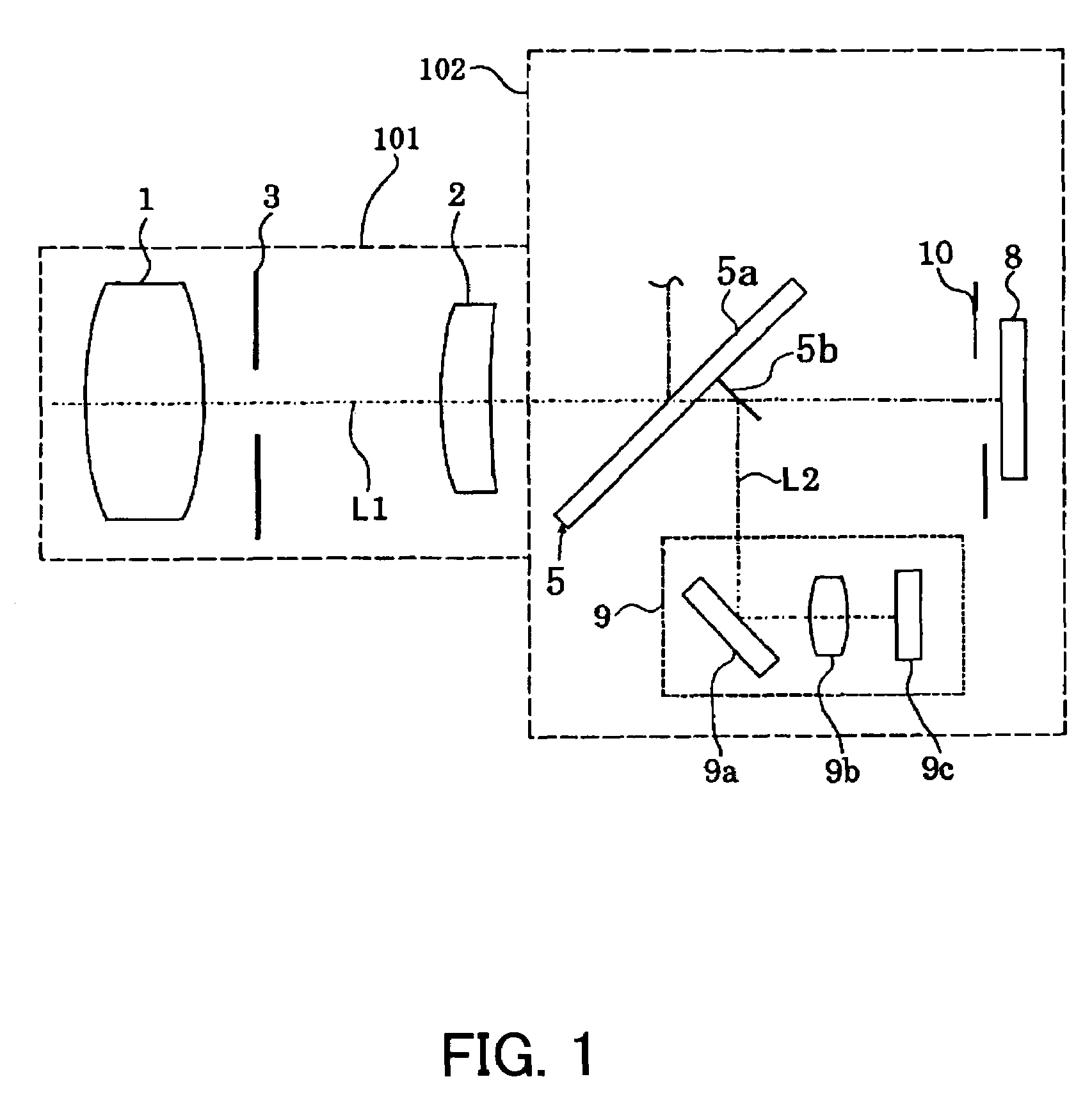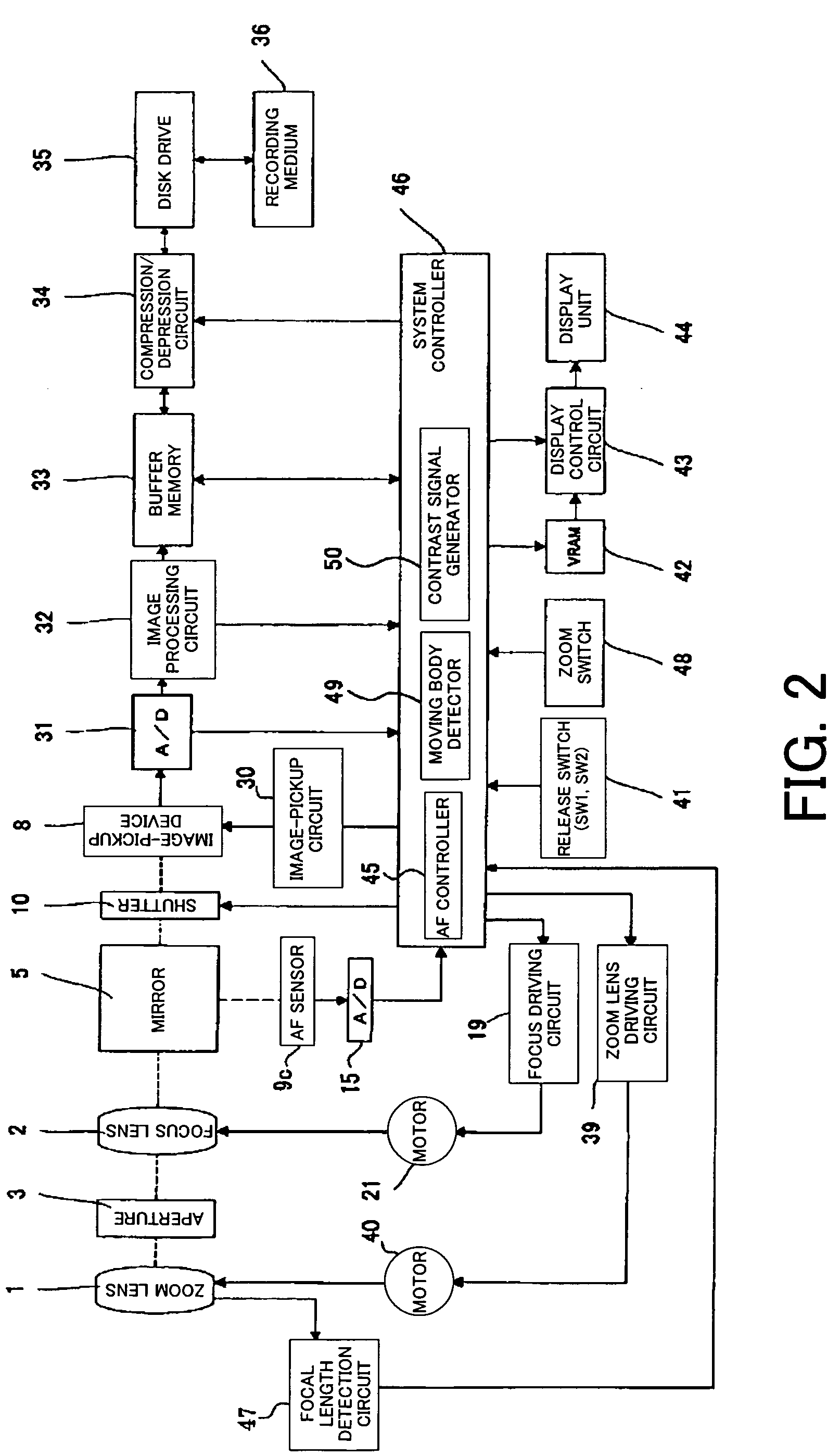Optical apparatus
a technology of optical equipment and optical axis, which is applied in the direction of camera focusing arrangement, printers, instruments, etc., can solve the problems of difficult to know whether the defocus is caused by front focus or rear focus, difficult to perform focus detection, and inconvenient methods, etc., to achieve fast focusing operation and accurate focusing
- Summary
- Abstract
- Description
- Claims
- Application Information
AI Technical Summary
Benefits of technology
Problems solved by technology
Method used
Image
Examples
embodiment 1
[0031]FIG. 1 shows the structure of main components of a camera system (an optical apparatus) which is Embodiment 1 of the present invention. The camera system of Embodiment 1 has a camera body 102 and a lens apparatus 101 which is mounted on the camera body 102. While Embodiment 1 will be described on the assumption that the camera system is an optical apparatus in which the lens apparatus 101 is removably mounted on the camera body 102, for example a single-lens reflex camera, it may be an optical apparatus integral with a lens.
[0032]Reference numerals 1 and 2 show image-taking lenses. Specifically, the image-taking lens 1 is a zoom lens which can be moved in the direction of an optical axis L to change the focal length of an image-taking optical system. The image-taking lens 2 is a focus lens which is moved in the direction of the optical axis L to adjust focus. Each of the lenses may be formed of a single or a plurality of lenses. Reference numeral 3 shows an aperture serving as...
embodiment 2
[0083]FIG. 10 illustrates Embodiment 2 of the present invention. FIG. 10 is a flow chart showing AF control in a camera system of Embodiment 2. Since a camera body 102, a lens apparatus 101, a circuit structure and the like are the same as those in Embodiment 1, description thereof is omitted.
[0084]The focal depth is larger as the focal length is smaller, and the focal depth is smaller as the focal length is larger, so that precise AF control needs to be performed when the focal length is large. Thus, in the camera system of Embodiment 2, the AF control is performed on the basis of a focal length detected by a focal length detection circuit 47.
[0085]First, the focal length detection circuit 47 detects the position of the zoom lens 1, and calculates the focal length based on the position of the zoom lens 1 and outputs the calculated focal length to a system controller 46 as focal length information.
[0086]If it is determined that the focal length information input to the system contro...
embodiment 3
[0092]FIG. 11 shows the structure of main components of a camera system (an optical apparatus ) which is Embodiment 3 of the present invention. The camera system of Embodiment 3 has some of the components different from those of the camera system (the optical apparatus ) described in FIG. 1. The common components are designated with the same reference numerals and description thereof is omitted. Embodiment 3 is characterized by a mirror 105.
[0093]Specifically, when the camera system is in an OVF (Optical View Finder) state as a first state, a half mirror 105a transmits part of luminous flux passing through image-taking lenses 1 and 2 toward an image plane and reflects the remaining luminous flux toward a viewfinder optical system, not shown, provided in a camera body 102. A sub mirror 105b disposed closer to the image plane than the half mirror 105a reflects the luminous flux transmitted through the half mirror 105a toward a focus detection unit 9 while the camera is not taking an i...
PUM
 Login to View More
Login to View More Abstract
Description
Claims
Application Information
 Login to View More
Login to View More - R&D
- Intellectual Property
- Life Sciences
- Materials
- Tech Scout
- Unparalleled Data Quality
- Higher Quality Content
- 60% Fewer Hallucinations
Browse by: Latest US Patents, China's latest patents, Technical Efficacy Thesaurus, Application Domain, Technology Topic, Popular Technical Reports.
© 2025 PatSnap. All rights reserved.Legal|Privacy policy|Modern Slavery Act Transparency Statement|Sitemap|About US| Contact US: help@patsnap.com



